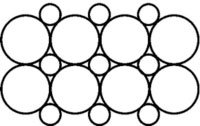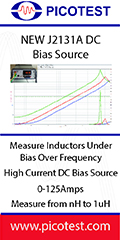 |
|
IN THIS ISSUE:
» Analysis, Simulation And Experimentation Enable Successful Design Of Power Supply Compensation
» Different Approaches To Learning And Applying Digital Signal Processing In Power Electronics
» Focus On Magnetics:
Interstitial Wire Interleaving Packs More Conductor Into Magnetic Windings
» Spotlight On Safety & Compliance:
Mounting Bridge Rectifiers: Compliance Needs Make It Complicated
» New Power Products
» Other Top Power News
From the Editor's Desk David G. Morrison
Editor, HOW2POWER TODAY

Electronics technology is continually evolving and advancing with new components, instruments and design tools to aid engineers in meeting new design goals. Several of the innovative components in this month’s Power Products section attest to this ongoing progress. Even in midst of the pandemic, component development and product launches proceed unabated. Some examples reported in this issue include a fully integrated voltage regulator IC, SiGe rectifiers, and a better rad hard MOSFET package. However, efforts to better understand and explain basic engineering concepts and design tasks, also evolve as evidenced by our two design features. Christophe Basso’s article on designing power supply compensation, reviews this familiar topic with a tutorial that explains in detail multiple ways to analyze and simulate the response of a power stage, tips on applying the three types of compensation, and advice on verifying the compensator design with a prototype and further analysis. While many of these techniques have been discussed before, new treatments of the subject like Basso’s help to illuminate aspects that may have been neglected in previous works, and reflect the author’s vision of how to tie the information together. Certainly, Dennis Feucht’s feature on digital signal processing does some of the latter, as he compares the different ways that the DSP subject has been explained in different math and engineering disciplines, helping engineers to grasp the connections between the various methods and how they are best applied (conceptually) in power electronics. He also reviews the classics of DSP literature, giving engineers guidance on which references have stood the test of time in explaining the subject. Enjoy these and other articles in the July issue.
|
|

 |
 |

|
HOW2POWER EXCLUSIVE DESIGN ARTICLES 
|
Analysis, Simulation And Experimentation Enable Successful Design Of Power Supply Compensation
by Christophe Basso, ON Semiconductor, Toulouse, France
Loop control represents an important aspect of the design of a switching power supply. However, for various reasons, its study is often relegated to the end of the project when the main components have already been selected. Through simple trial and error, it is sometimes possible to get the impression that a design delivering an acceptable transient response on the oscilloscope is ready for production but this is a very unwise and potentially costly attitude. Without a thorough analysis backed up by simulations and loop measurements, you have no idea what phase and gain margins look like and how solid they are. It is very likely that such a loosely designed converter will fail in production or shortly after being powered in the field. To keep you away from such situations, this article reviews some of the tools currently available to let you calculate, simulate and measure your prototype’s control loop before safely pressing the production start button.
Read the article…
|

Once you have the transfer function
magnitude/phase plot in hand for your
power stage, you can think of a
compensation strategy consisting of
placing poles, zeroes and gain (or
attenuation) at various frequency
locations to meet your design goals |

|

A “mixed-waveform” analog and
digital system with a sampled
feedback loop such as might be
found in a digitally controlled power
supply. ADC and DAC are sample-
hold components that convert
between ratios of digital counts and
voltage ratios. |
Different Approaches To Learning And Applying Digital Signal Processing In Power Electronics
by Dennis Feucht, Innovatia Laboratories, Cayo, Belize
One of the early confusion factors in learning digital signal processing (DSP) is the rather different emphases placed upon it in DSP books. If you learn DSP from a book like the Prentice-Hall classic, Digital Signal Processing, by Oppenheim and Schafer (or from Alan Oppenheim’s excellent MIT video course), or even more so, from another Prentice-Hall book, Digital Filters, by R.W. Hamming, you will get a filter-oriented view of DSP. On the other hand, if you learn it by reading digital control books, you will acquire a control-oriented view. And more basically, if you learn it by reading numerical analysis books of mathematics, you might wonder how it is related to electronics (or engineering). What then is the best approach to an efficient acquisition of the subject? In this article, the author explores this issue from a power electronics perspective.
Read the article…
|


FOCUS ON MAGNETICS 
Sponsored by Payton Planar Magnetics
A monthly column presenting information on power magnetics design, products, or related technology |

Interstitial Wire Interleaving Packs More Conductor Into Magnetic Windings
by Dennis Feucht, Innovatia Laboratories, Cayo, Belize
One of the limitations on winding efficiency is the packing factor, kp, the fraction of winding area that is conductor. Ideally the conductive part of a winding—the copper or aluminum part of the wire turns—would completely fill the area allotted to a particular winding, and the current and power density would then be maximum. However, gaps between round wires result in areas not conducting current. This article proposes a way to reduce gaps and thus increase the winding fill factor, kf by filling these gaps with smaller wires. After reviewing the various packing factor components that quantify winding density, we’ll analyze how to determine the optimum wire size for the smaller wire in square-layered and hexagonal-layered winding configurations. We’ll also determine the improvement in fill factor obtained in each case.
Read the full article…
|

One possible way to alleviate the
packing factor problem is to fill in
the gaps between adjacent wires
in a layered winding with
smaller-sized wire |

 |
 |

SPOTLIGHT ON SAFETY & COMPLIANCE 
Sponsored by Power Integrations
A monthly column discussing standards and regulatory requirements affecting power electronics |

Mounting Bridge Rectifiers: Compliance Needs Make It Complicated
by Kevin Parmenter, Chair, and James Spangler, Co-chair, PSMA Safety and Compliance Committee
Among the various types of semiconductor devices, bridge rectifiers are somewhat unusual in that they are subject to safety agency certifications such as UL. These devices have agency approvals because they often connect to the ac mains in their applications. In addition, higher-power bridge rectifiers are usually mounted on a chassis or heatsink, such that they become part of the isolation safety barrier and therefore subject to creepage and clearance considerations as well as hi-pot testing. There are also maximum touch temperatures that affect rectifier usage. The requirements for isolation and heat removal are often in conflict. This article discusses techniques and strategies for satisfying these requirements—real world best practices—and highlights some of the pitfalls to avoid when mounting bridge rectifiers in your applications.
Read the full article…
|

 |
 |

 |
|
|

 — POWER PRODUCTS IN 3 IMAGES OR LESS — POWER PRODUCTS IN 3 IMAGES OR LESS 
|


Empower Semiconductor’s EP70xx
Integrated Voltage Regulators. |
Voltage Regulator ICs Take Monolithic Integration to Another Level
 Photo: The IVR is a high-performance switching regulator that is said to eliminate or integrate all discrete components in a single device. The company is touting the IVR as the “world’s fastest and smallest voltage regulator”. Photo: The IVR is a high-performance switching regulator that is said to eliminate or integrate all discrete components in a single device. The company is touting the IVR as the “world’s fastest and smallest voltage regulator”.
 Drawing: A PMIC solution implementing multiple point-of-load converters (POLs) with up to 11 A of total output requires 40+ discrete components and 280 mm2 of pc-board space. An IVR with multiple POLs capable of up to 10 A of total output requires only one device and occupies only 17 to 25 mm2 of board area. Drawing: A PMIC solution implementing multiple point-of-load converters (POLs) with up to 11 A of total output requires 40+ discrete components and 280 mm2 of pc-board space. An IVR with multiple POLs capable of up to 10 A of total output requires only one device and occupies only 17 to 25 mm2 of board area.
See the full story…
|


 |

|


IR HiRel’s SupIR-SMD package. |
A Better Package For Rad Hard MOSFETs—PCBs Meet Their (CTE) Match
 Photo: Optimized for surface-mount attach and capable of direct-to-PCB mounting, the SupIR-SMD relieves thermally-induced stress in the solder joint between the PCB and device package, while also minimizing thermal and electrical resistance. Photo: Optimized for surface-mount attach and capable of direct-to-PCB mounting, the SupIR-SMD relieves thermally-induced stress in the solder joint between the PCB and device package, while also minimizing thermal and electrical resistance.
 Drawing: Traditionally, designers have resorted to a “dead bug” and lead configuration, where the packages are flipped upside down and soldered to the PCB via leads. Dead bug soldering dissipates heat sub-optimally and decreases MOSFET power capacity. This practice can be avoided by using the SupIR-SMD. Drawing: Traditionally, designers have resorted to a “dead bug” and lead configuration, where the packages are flipped upside down and soldered to the PCB via leads. Dead bug soldering dissipates heat sub-optimally and decreases MOSFET power capacity. This practice can be avoided by using the SupIR-SMD.
See the full story…
|

Nexperia’s PMEGxGxELR/P SiGe
rectifiers.
|
Silicon Germanium Rectifiers Enable Higher Efficiency In High Temperature Applications
 Graph: SiGe rectifiers enable new tradeoffs in forward voltage vs. leakage current for rectifiers used in power designs at 100 to 200 V. The rectifiers feature reduced reverse current compared to Schottky diodes, yet also exhibit lower forward voltage versus fast recovery rectifiers, leading to low power losses. Graph: SiGe rectifiers enable new tradeoffs in forward voltage vs. leakage current for rectifiers used in power designs at 100 to 200 V. The rectifiers feature reduced reverse current compared to Schottky diodes, yet also exhibit lower forward voltage versus fast recovery rectifiers, leading to low power losses.
 Graph: The high thermal stability of SiGe rectifiers also distinguishes these devices from Schottkys. The SiGe rectifiers are stable at up to and beyond 175°C, which is the specified limit of the CFP package. Graph: The high thermal stability of SiGe rectifiers also distinguishes these devices from Schottkys. The SiGe rectifiers are stable at up to and beyond 175°C, which is the specified limit of the CFP package.
See the full story…
|

 |

|

Dialog Semiconductor’s SLG47105
HV PAK IC.
|
Configurable Mixed-Signal IC Adds High-Voltage Capability For Driving Motors
 Diagram: A member of the GreenPAK product family, the HV PAK combines configurable, mixed-signal logic and high-voltage H-bridge functionality in a 2- x 3-mm QFN. A single device can drive two brushed dc motors, a single stepper motor, a solenoid, or any other load requiring up to 1.5 Arms per output, and an operating voltage up to 13.2 V. Diagram: A member of the GreenPAK product family, the HV PAK combines configurable, mixed-signal logic and high-voltage H-bridge functionality in a 2- x 3-mm QFN. A single device can drive two brushed dc motors, a single stepper motor, a solenoid, or any other load requiring up to 1.5 Arms per output, and an operating voltage up to 13.2 V.
See the full story…
|

Renesas Electronics’ HIP2211 and
HIP2210 half-bridge MOSFET drivers.
|
100-V Half-Bridge MOSFET Drivers Offer Ruggedness And High Performance
 Diagram: The HIP2211 is a next-generation pin-compatible upgrade to Renesas’ popular ISL2111 bridge driver, while the HIP2210 offers a tri-level PWM input to simplify power supply and motor drive design. When compared with the ISL2211, the HIP2211 provides lower typical propagation delay, lower typical delay matching and a wider operating voltage range. Diagram: The HIP2211 is a next-generation pin-compatible upgrade to Renesas’ popular ISL2111 bridge driver, while the HIP2210 offers a tri-level PWM input to simplify power supply and motor drive design. When compared with the ISL2211, the HIP2211 provides lower typical propagation delay, lower typical delay matching and a wider operating voltage range.
See the full story…
|


|










|

 According to a report from MarketsandMarkets, the global power electronics market size is expected to grow from $35.1 billion U.S. in 2020 to $44.2 billion by 2025, at a CAGR of 4.7%. According to a report from MarketsandMarkets, the global power electronics market size is expected to grow from $35.1 billion U.S. in 2020 to $44.2 billion by 2025, at a CAGR of 4.7%.
 The Applied Power Electronics Conference is reaching out to industry experts to review digests of technical paper submissions for the APEC 2021 conference, while also issuing its call for papers. The Applied Power Electronics Conference is reaching out to industry experts to review digests of technical paper submissions for the APEC 2021 conference, while also issuing its call for papers.

ABOUT THIS NEWSLETTER: Thank you for reading HOW2POWER TODAY.
How2Power sends no more than one e-mail per month to registered users. Continuing your subscription ensures you'll receive future newsletters. Manage Your Subscription
©2020 All rights reserved. www.how2power.com
|
|